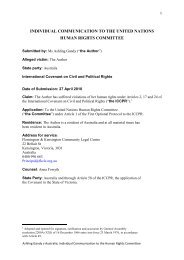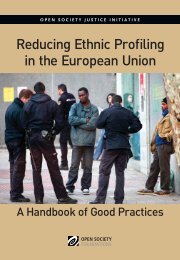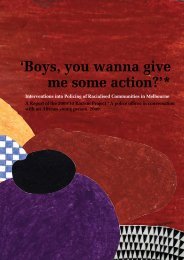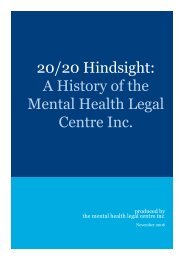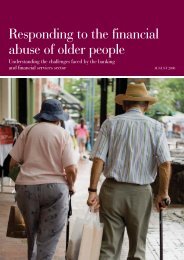Fact sheet 8 ASBO Threat.pub - Community Law
Fact sheet 8 ASBO Threat.pub - Community Law
Fact sheet 8 ASBO Threat.pub - Community Law
You also want an ePaper? Increase the reach of your titles
YUMPU automatically turns print PDFs into web optimized ePapers that Google loves.
SmartJustice<strong>Fact</strong><strong>sheet</strong>8/10DEMONIZING OUR KIDS: THE <strong>ASBO</strong> THREAT“<strong>ASBO</strong>s have thepotential to overtlycriminalize poverty,young people’saccess to <strong>pub</strong>licspace andhomelessness.Stan Winford, Fitzroy LegalServiceA call for Anti-Social Behaviour Orders (<strong>ASBO</strong>s) by certain political parties should start thealarm bells ringing here in Victoria. <strong>ASBO</strong>’s are a potential election issue that could see moreyoung and vulnerable Victorians end up on charges for behaviour that is not even against thelaw.According to community lawyers, <strong>ASBO</strong>s have the potential not only to further constrict therapidly diminishing <strong>pub</strong>lic space available to the homeless, but to overtly criminalize poverty,young people’s access to <strong>pub</strong>lic space and homelessness. 1Introduced in the United Kingdom in 1998, they are a civil order which prohibit behaviour thatis deemed to be ‘anti-social’, be it a certain activity or entrance into a certain area. Breach ofthis order is a criminal offence, punishable by up to five years imprisonment. They can beissued to anybody over the age of 10 years old.Concerns<strong>ASBO</strong>s will most likely disproportionately impact on young people, particularly marginalisedand disadvantaged young people, and can criminalise non-criminal behaviours, drawing moreyoung people into the criminal justice system.But it's important to remember that most young people, most of the time, do not engage in antisocialbehaviours and that young people themselves are more at risk than other age groups ofbeing a victim of crime - and socially excluded young people are at even greater risk. 2Serious concerns about <strong>ASBO</strong>s, include:1. How do you define ‘anti-social behaviour’! Playing football in the street, and beingsarcastic to one’s neighbours have been defined as ‘anti social’. Anti-social behaviour isdefined as anything that is ‘likely to cause offence, harassment or fear’. As everyonedefines this differently it means anything could be subject to an <strong>ASBO</strong>!2. Kids are targeted. The experience in the UK has been that a huge number of youngpeople have come into contact with the criminal justice system. Breaches of orders can leadto 5 years imprisonment. Kids now get a criminal record for, in many cases, just being kids!3. Erosion of presumption of innocence. Usually civil cases are decided on the ‘balance ofprobabilities’. In the UK A special exception was made for <strong>ASBO</strong>s, where there had to beguilt ‘beyond reasonable doubt’ of committing an anti-social crime. However, hearsayevidence can be heard in <strong>ASBO</strong> hearings, perhaps explaining why 99 out of every 100applications for <strong>ASBO</strong>s in Britain are granted4. Potential for misuse by police. An <strong>ASBO</strong> could be obtained on the basis of hearsayevidence relatively easily, as noted above. Breach of this <strong>ASBO</strong>, far easier to detect andprove then the original behaviour, would then attract a criminal punishment. A criminalconviction could thus be obtained without ever proving any original crime.5. They don’t solve anything. <strong>Law</strong>s such as <strong>ASBO</strong>S do not prevent problematicbehaviours because they do not address the reasons for the behaviour.Smart Justice alternatives1. Stan Winford, ‘The Rise and Rise of the<strong>ASBO</strong>: A new legal threat? ‘ ParityMagazine. Feb 20062. Australian Institute of Criminology(2005) Crime victimisation in Australia: keyresults of the 2004 International CrimeVictimisation Survey, p.11It is normal for people - particularly young people - to gather and socialise in <strong>pub</strong>lic. It is alsoquite common for some people to feel threatened by the presence of groups in <strong>pub</strong>lic. So, inaddressing <strong>pub</strong>lic anti-social behaviours it's crucial to get both sides of the story and to find abalance between the concerns of the complainants and those being complained about.Instead of the ‘quick-fix’ offered by <strong>ASBO</strong>s, successful crime prevention needs to address theunderlying causes of the behaviour including issues such as unemployment, poverty, lack ofhousing, early school leaving, mental health issues or drug and alcoholThis fact<strong>sheet</strong> is part of a series produced by the Smart Justice campaign,co-ordinated by the Federation of <strong>Community</strong> Legal Centres Vic.Further information and the series of fact<strong>sheet</strong>s are available at www.communitylaw.org.au. December 2006
Smart Justice <strong>Fact</strong><strong>sheet</strong>Page 2 of 2dependency.A good system aims to prevent low risk young people from entering the criminal justicesystem and to rehabilitate more serious young offenders. Such intensive support takes along-term view and assists in diverting young people from further criminal behaviours andaddresses the underlying causes of offending behaviours.“A good systemaims to preventyoung people fromentering thecriminal justicesystemValuing and supporting young peopleA recent study of 10,000 Victorian adolescents has found that they are less likely to smoke,binge-drink or try illicit drugs if they feel safe and valued at school. They are also less likelyto engage in under-age sex or antisocial behaviour such as vandalism or theft. 3Young people are less likely to indulge in behaviour that can be destructive and dangerouswhen schools are prepared to listen to them and respond to their needs. If young peoplecan access intensive support programs including housing services, mental health services,drug and alcohol programs, family welfare and counselling services, employment servicesthis will reduce antisocial behaviour, and promote social inclusion.Other examples of community support programs include:• youth arts programs such as creating a mural to reduce instances of graffiti on<strong>pub</strong>lic space sites 4• sporting activities and training to promote pro-social behaviour by developing theconfidence, social interaction skills, connection with the community of young people 5Developmental approach to policy planningAdopt an approach where the emphasis is on dealing with social problems with youngpeople seen as part of the solution and legitimate users of <strong>pub</strong>lic space. There are somegood examples where young people and marginalised groups have been involved in policyplanning and development with positive results. This may involve developing additionalrecreational opportunities for young people (and not simply the ubiquitous skate park).Some shopping centres around Australia have developed protocols between young people,security and management to ensure these spaces are utilised and enjoyed by all.3. 2000 Stories: Victorian AdolescentHealth Cohort Study. Centre forAdolescent Health 2006 contact SherylHemphill 1800 706 101 or2000stories@mcri.edu.au4. See The Good Graffiti Squad TheGraffiti and Disorder Conferenceconvened by the Australian Institute ofCriminology in conjunction with theAustralian Local Government Associationand held in Brisbane, 18-19 August20035. See: Australian Institute of Criminologyhttp://www.ausport.gov.au/isp/documents/AICTIPaper249.pdf, andWarrington, Georgina, and PaulWright. "Impact youth crime prevention.(Programs And Practice)." Youth StudiesAustralia 22.1 (March 2003): 46(5)6. See http://www.jss.org.au/programmes/com_justice.htmlThis fact<strong>sheet</strong> is for information anddiscussion purposes only. It does notnecessarily represent the views orpolicy positions of organisationsinvolved in the Smart Justicecampaign.During the 2006 Commonwealth Games, a Victorian protocol for who are homeless in <strong>pub</strong>licplaces was developed between police, the State Government, local councils and communitysector agencies to ensure homeless people were treated appropriately and not simplymoved from the streets during the Games.<strong>Community</strong> policing<strong>Community</strong> policing goes beyond law enforcement andpunitive measures such as <strong>ASBO</strong>s. It is a problemsolving approach to policing aiming to build trustbetween police, young people and the community toreduce anti-social behaviour.Youth Diversion ProgramsIdentify young people at risk of involving themselves in criminal and anti-social behaviourand aim to divert them away from crime through intervention and prevention programs.Diversionary approaches include police cautioning, conferencing, bail and a range ofdiversionary programs such.• group conferences, conducted by a mediator and attended by a youngoffender, his or her parent or guardian and persons affected by the youngperson's offending, develops a plan with the purpose of assisting the youngperson in avoiding further offending. 6• Ropes Program (Victoria) aims to turn negative contact with the police and courtinto positive contact by bringing together a young offender and the policeofficer who charged them. The young offender attends a course with policeofficers to break down barriers and help each to see things from the other'sperspective.Production of this <strong>pub</strong>lication was madepossible by a financial grant from theVictoria <strong>Law</strong> Foundationwww.smartjustice.org.au



